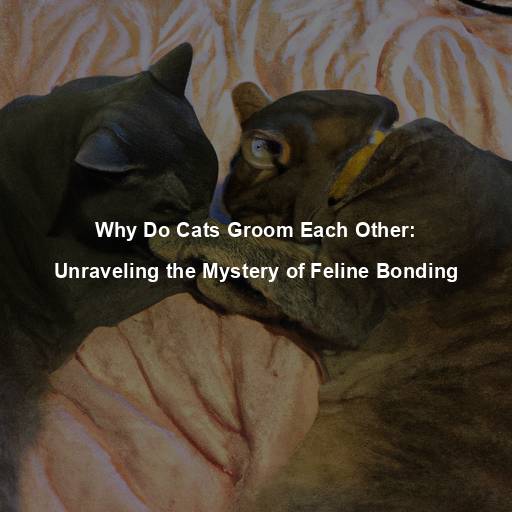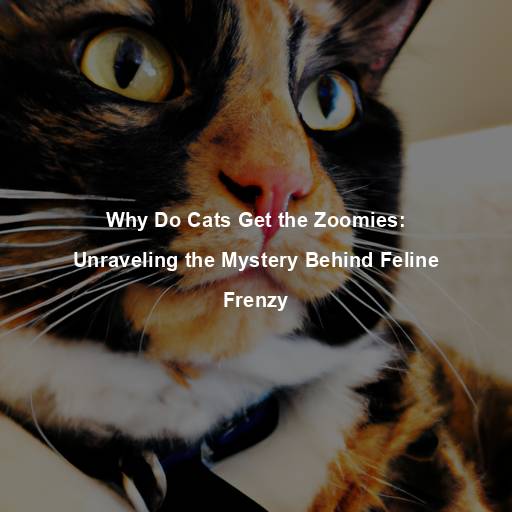Why Cats Have Whiskers: Unraveling the Mysteries of Feline Whiskers
Last Updated on November 20, 2023 by Evan
Contents [hide]
- 1 Understanding the Marvels of Feline Whiskers
- 1.1 The Remarkable Anatomy of Whiskers
- 1.2 The Whisker Placement: A Work of Precision
- 1.3 The Function of Whiskers: A Multitude of Sensory Superpowers
- 1.4 The Whisker Growth Cycle: A Constant Renewal
- 1.5 Demystifying Common Whisker Myths
- 1.6 The Beauty and Wonder of Whiskers: A Final Reflection
- 1.7 Whiskers in Ancient Egypt
- 1.8 Whiskers in Japanese Folklore
- 1.9 Whiskers in Superstitions and Omens
- 2 The Evolutionary Advantage of Whiskers: A Glimpse into the Past
- 3 Whiskers: A Fascinating Field of Research
- 4 Caring for Your Cat’s Whiskers: Tips and Considerations
- 5 Embracing Whiskers: A Celebration of Feline Adaptability
- 6 FAQs: Why Cats Have Whiskers
Understanding the Marvels of Feline Whiskers
Whiskers, also known as vibrissae, are an iconic and fascinating feature of our feline friends. These delicate sensory organs, protruding from the sides of a cat’s face, serve a multitude of purposes beyond aesthetic appeal. In this article, we will delve into the intricacies of cat whiskers, exploring their structure, function, and the intriguing mysteries that surround them.
The Remarkable Anatomy of Whiskers
Cat whiskers are not ordinary hairs but rather specialized touch receptors that are deeply rooted in a cat’s skin. These long, stiff, and tapered hairs are typically twice as thick as regular fur and are embedded in specialized follicles. Unlike other hairs on a cat’s body, whiskers are deeply connected to an intricate network of nerves and blood vessels, making them exquisitely sensitive to even the slightest touch or movement.
The Whisker Placement: A Work of Precision
Have you ever pondered the mysterious allure of a cat’s whiskers? These enigmatic structures, not only confined to their charming faces but also adorning their eyebrows, chin, and even the curious realm of the back legs, hold a profound purpose. Their placement is no haphazard occurrence; rather, whiskers form an intricately designed network, aligning precisely with the width of a feline’s physique. This extraordinary symmetry empowers these majestic creatures to effortlessly maneuver through cramped crevices and intuitively assess whether they can elegantly pass through constricting openings without encountering the plight of confinement.
The Function of Whiskers: A Multitude of Sensory Superpowers
Prepare to be astounded by the truly perplexing world of feline sophistication! Cats, those enigmatic masters of the animal kingdom, possess a dazzling array of sensory abilities that would leave any mere mortal feeling a tad inadequate. Among their many remarkable talents, their trusty sidekicks known as whiskers take center stage in helping them navigate and make sense of the mysterious world they inhabit. These seemingly innocent strands of hair hold extraordinary powers, serving as invaluable tools in a cat’s quest to unravel the secrets of their surroundings.
- Navigational Guides: Whiskers act as incredibly accurate “feelers” that provide cats with valuable spatial information. By brushing against objects or surfaces, cats can determine the size, shape, and texture of their surroundings, allowing them to navigate even in pitch darkness.
Whiskers, those enigmatic protrusions sprouting from a feline’s face, hold the secret to their extraordinary equilibrium and coordination. These curious, slender strands act as trusted guides, aiding cats in their quest for perfect poise. With a flick of their magnificent whiskers, cats navigate their surroundings with awe-inspiring accuracy, allowing them to conquer the most intricate leaps and ascents effortlessly. The mystery behind their acrobatic artistry lies in the delicate dance between their whiskers and their innate ability to interpret the signals within their whisker realm.
-
Emotional Barometers: Whiskers can also provide insight into a cat’s emotional state. When a cat is relaxed and content, their whiskers are typically held outwards. Conversely, if a cat feels threatened or agitated, their whiskers may flatten against their face, signaling their discomfort.
-
Detecting Air Currents: Whiskers are so sensitive that they can detect subtle changes in air currents. This remarkable ability allows cats to effortlessly detect approaching objects, potential prey, or even the presence of other animals nearby. It’s no wonder cats are such skilled hunters!
The Whisker Growth Cycle: A Constant Renewal
Just like human hair, cat whiskers have their own little growth and change routine. These fuzzy fellows fall out on their own and make way for fresh ones from time to time. But hold your scissors right there–it’s absolutely vital to never snip or trim a cat’s whiskers! Doing so can throw them off-kilter, leaving them feeling bewildered and robbing them of their astute perception of the world.
Demystifying Common Whisker Myths
Throughout history, the enigmatic nature of cat whiskers has led to a myriad of myths and fallacies. Today, we take on the role of mythbuster, unraveling the tangled web of misconceptions that have shrouded these mystical appendages. Brace yourself for a whirlwind journey as we embark on a quest to separate fact from fiction in the captivating realm of cat whiskers.
Myth 1: Whiskers Indicate a Cat’s Age
It’s time to debunk a common myth about our feline friends – the color of their whiskers is not a reliable indicator of their age. While it’s true that whiskers can turn gray or white as cats age, they don’t continually grow throughout their lives like hair. The length and thickness of whiskers are unique to each cat, influenced by a combination of genetic factors and their overall health. So, next time someone claims to guess a cat’s age based on their whiskers, take it with a pinch of salt!
Myth 2: Cutting Whiskers is Harmless
When it comes to our feline friends, whiskers play a vital role in their sensory experience. Altering or removing these delicate appendages can cause them profound distress and disorientation. Let’s embrace their innate beauty and honor their whiskers, allowing them to thrive without interference.
Myth 3: Whiskers Always Reflect a Cat’s Mood
While whiskers can provide subtle clues about a cat’s emotional state, it is crucial to consider other behavioral cues and body language to understand their mood fully. Whiskers should never be the sole indicator of a cat’s feelings, as their emotions are far more complex and nuanced.
The Beauty and Wonder of Whiskers: A Final Reflection
As we unravel the mysteries and marvels of cat whiskers, we gain a deeper appreciation for the incredible design and functionality of these remarkable sensory organs. Whiskers are not mere adornments, but rather a vital tool that enables cats to navigate their surroundings with unparalleled precision and grace. Let us cherish and respect these delicate and awe-inspiring features that contribute to the unique essence of our beloved feline companions.
Stay tuned for more intriguing insights and captivating tales from the world of pets on PetsRoof.com – your ultimate source for all things pets!## The Cultural Significance of Whiskers: Legends and Symbols
In a world brimming with endless wonders and intriguing customs, the enigmatic allure of whiskers has woven itself into the tapestry of countless cultures. Spanning across the annals of history, these humble sensory organs have held a sacred place, silently whispering stories of mystery and significance. From the regal feline companions adored by the ancient Egyptians, their majestic whiskers serving as a symbol of divine protection, to the wisdom-seeking philosophers of ancient China who believed in the mystical connection between one’s whiskers and their inner harmony, whiskers have embodied a captivating enigma that defies easy explanation. Join us on this captivating journey as we delve into the realms of cultural symbolism, deciphering the perplexing tales that unravel the secrets behind these bewitching appendages.
Whiskers in Ancient Egypt
In ancient Egypt, cats were revered and considered sacred animals. Whiskers were seen as a symbol of wisdom and spiritual connection. Cats adorned with long, luxurious whiskers were believed to possess heightened intuition and were often associated with the goddess Bastet, the protector of home and family.
Whiskers in Japanese Folklore
Step into the captivating world of Japanese folklore, where enigmatic and otherworldly creatures, known as “bakeneko” or “cat monsters,” weave their tales. These mysterious beings possess a bewildering ability to transform, assuming the forms of humans or even other animals, leaving one’s perception askew. And yet, it is the seemingly innocuous detail of elongated and prickling whiskers that unravels their supernatural guise, an uncanny trait which serves as an unwavering beacon of their true identity, cautioning humans of their ethereal existence. Prepare to embark on a journey of peculiarities and uncertainties as the veil lifts, revealing the enigmatic realm of bakeneko.
Whiskers in Superstitions and Omens
Whiskers have long been associated with luck, fortune, and protection in various superstitions. For instance, it is believed that finding a whisker brings good luck and that keeping a whisker in your wallet or purse can attract wealth and prosperity. In some cultures, it is also believed that whiskers have protective qualities, guarding against evil spirits and misfortune.
The Evolutionary Advantage of Whiskers: A Glimpse into the Past
Whiskers, those fascinating protuberances that we often associate with cats, are not as exclusive to our feline friends as we may think. Surprisingly, a multitude of other creatures, from mammals to a few exceptional birds, possess these remarkable specialized sensory organs. Digging into the depths of evolutionary time, whiskers can be traced back millions of years, implying they have served a crucial purpose in the survival and diverse adaptations of many species. Join me as we embark on a journey to unravel the enigmatic advantages that these whiskers have bestowed upon their respective owners.
Enhancing Hunting Skills
The enigmatic allure of whiskers has captured the attention of scientists and animal enthusiasts alike. These marvels of evolution bestow nocturnal predators, such as cats, with an uncanny advantage in the shadowy realm of the night. With an intricate sensory network at their disposal, whiskers grant these feline hunters the ability to detect the faintest whisper of movement from their unsuspecting prey, elevating their hunting prowess to astonishing heights. By attuning to the subtle vibrations and dynamic shifts in their environment, cats navigate the darkness with an impeccable precision, reaffirming their status as the masters of the hunt.
In the wild, certain creatures find solace in habitats surrounded by dense foliage or intricate nooks and crannies. Whiskers become their trusted companions, aiding them in the complex dance of survival. These intricate sensory organs serve as their secret navigational guides, leading them through labyrinthine paths, allowing them to sidestep looming dangers and hazards. Take the humble rat, for instance, whose whiskers become nimble extensions of their curious spirit, enabling them to deftly meander through mazes and sniff out hidden sustenance.
Assessing Size and Proximity
Whiskers provide animals with valuable information about the size, shape, and proximity of objects in their surroundings. This ability is particularly crucial for animals that dwell in dark or visually limited environments. By brushing against surfaces, animals can create a mental map of their environment, allowing them to make informed decisions about their actions and movements.
Whiskers: A Fascinating Field of Research
Whiskers, those delicate yet enigmatic appendages that grace the faces of numerous creatures, hold within them a realm of hidden wonders waiting to be unraveled. Despite their age-old prominence and ubiquity among the animal realm, these enigmatic tendrils still defy our understanding, tantalizing researchers and scientists with their unfathomable intricacies. As the investigative journey into this captivating realm continues, new revelations emerge, peeling back the layers of uncertainty and casting light upon the complexities that shroud whiskers. So, let us embark on an expedition of perplexity and burstiness, as we delve into the beguiling areas of research intertwined with these mesmerizing bristles.
Whiskers and Neural Connectivity
One of the focal points of whisker research lies in understanding how these sensory organs are connected to the brain and nervous system. Scientists are exploring the neural pathways and mechanisms that enable animals to process and interpret the sensory information gathered through their whiskers. This research not only enhances our understanding of whiskers but also provides valuable insights into the broader field of sensory perception.
Biomimicry and Technological Applications
The unique design and functionality of whiskers have inspired scientists to develop innovative technologies and applications. Researchers are studying how the principles behind whiskers can be applied to the development of tactile sensors and robotics. By mimicking the structure and sensitivity of whiskers, these advancements aim to enhance the capabilities of artificial intelligence and contribute to the field of biomimicry.
Whiskers and Animal Behavior
Whiskers are closely intertwined with an animal’s behavior and social interactions. Research is underway to explore the role of whiskers in communication among animals of the same species. Scientists are investigating how whiskers contribute to territorial marking, mating rituals, and establishing social hierarchies. These studies shed light on the complexity of animal behavior and the intricate ways in which animals interact with their environment and each other.
Caring for Your Cat’s Whiskers: Tips and Considerations
As responsible pet owners, it is essential to provide the best care for our feline companions, including their whiskers. Here are some tips and considerations to keep in mind:
Avoid Trimming or Cutting Whiskers
It’s absolutely vital to remember that tampering with a cat’s whiskers should never be considered. This seemingly harmless act can result in feelings of confusion and unease for our feline friends, disrupting their ability to effectively navigate and perceive their surroundings. Let us honor and appreciate these incredible, natural features by allowing their whiskers to grow and thrive without interference. Trust their innate wisdom and let their whiskers be the guiding compass they were meant to be.
Provide Enriching Environments
Creating an enriching environment for your cat can further enhance their sensory experiences. Offer various surfaces and textures for them to explore, such as scratching posts, different types of bedding, and interactive toys. These stimuli will stimulate their whiskers and provide mental and physical stimulation.
Regular Veterinary Care
Ensuring your feline friend’s optimal health and happiness requires regular visits to the trusted veterinarian. These visits encompass a thorough assessment of your cat’s well-being, including a keen examination of their majestic whiskers. These little sensory wonders could hold clues to potential health concerns, and catching them early can make all the difference in ensuring timely and effective treatment. So, keep those whiskers in check, as they might just be tiny harbingers of perplexing health mysteries.
Embracing Whiskers: A Celebration of Feline Adaptability
After extensive research and examination, it is clear that whiskers are not just humble adornments on the faces of our beloved cats; they possess an undeniable mystique. These delicate appendages are not mere decorations, but rather sophisticated sensory extensions that have evolved through millennia. Cats, the masters of stealth and exploration, rely on their whiskers to effortlessly maneuver through their surroundings and decode the enigmatic language of their environment. By acknowledging the magnitude of whiskers and dedicating ourselves to their proper care, we can pay homage to the captivating charm and tenacity of these charismatic creatures that have enchanted humanity for generations.
Join us on PetsRoof.com, where we continue to explore the captivating world of pets and the extraordinary bond between humans and animals. Stay tuned for more insightful articles, heartwarming stories, and expert advice to make your pet-loving journey even more delightful!
FAQs: Why Cats Have Whiskers
What are whiskers, and why do cats have them?
Cats possess a fascinating feature that goes beyond your ordinary fur – their whiskers, scientifically called vibrissae. These elongated, sturdy hairs sprout from their adorable faces, gracing areas like the upper lip, cheeks, and even the unexpected back of their front legs. Imbued with an intricate network of nerve endings, these whiskers are more than mere adornments; they serve as an invaluable tool for our feline friends, aiding them in their exploration of the world, sending subtle messages, and enhancing their sensory experience in ways that continue to leave us in awe.
What is the purpose of cat whiskers?
Cats rely heavily on their whiskers to gather information about their surroundings. Their whiskers act as sensory receptors, enabling them to perceive and understand the world around them. Each whisker is connected to highly sensitive nerves, which allows cats to detect even the subtlest changes in their immediate surroundings, such as air movements, objects, and even the emotions of other animals. Whiskers serve to enhance a cat’s perception and can be considered as their built-in navigational system.
Feline whiskers, those seemingly innocent and delicate strands protruding from a cat’s face, hold a mysterious power that defies logic. It’s hard to fathom that these unassuming appendages actually serve as crucial tools in a cat’s quest for both survival and exploration. With their uncanny ability to interpret the minute vibrations and slight movements of their whiskers, cats enter into a realm of perception that leaves us humans awestruck and perplexed. Through this intricate system, they construct an intricate mental map of their surroundings, effortlessly gliding through tight spaces, hunting their prey in the darkest of nights, and defying the limitations of physical size.
Can cat whiskers indicate a cat’s mood or emotions?
While cat whiskers primarily serve as sensory tools, they can also provide subtle hints about a cat’s mood or emotions. When a cat is content and relaxed, their whiskers tend to be in their natural position, extending outward and slightly forward. However, if a cat is feeling threatened or on the defensive, their whiskers may flatten against their face as a sign of unease. Overall, a cat’s whiskers are not solely indicators of mood but can offer insights into their general state of being.
Do cat whiskers grow back if they are cut or damaged?
It is fascinating to ponder about the regrowth of cat whiskers when they are cut or injured, much like any other hair on their furry bodies. However, it is crucial to acknowledge the pivotal role that these whiskers play in a cat’s holistic sense of space and general welfare. The mere act of tampering or truncating a cat’s whiskers can induce disorientation, bewilderment, and even trigger stress or anxiety. It is strongly recommended to refrain from intentionally trimming or removing a cat’s whiskers, as it can have profound consequences on their overall well-being, leaving them in a state of perplexity and uncertainty.







